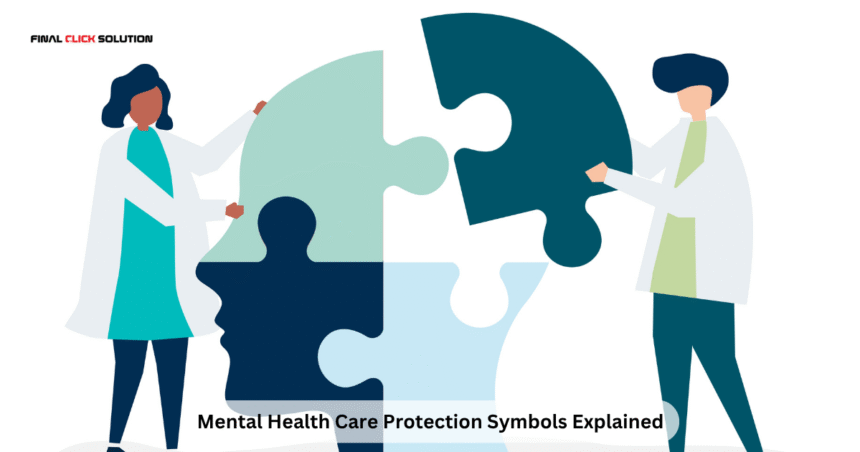In a world where discussions about mental health are finally gaining the attention they deserve, symbols have emerged as powerful tools for communication and awareness. Mental health care protection symbols serve as visual representations of understanding, support, and advocacy for mental well-being. They not only promote awareness but also convey messages of hope, healing, and unity across cultures and communities.
This article explores the origins, meanings, and uses of mental health symbols, along with their growing importance in promoting emotional wellness and mental health advocacy worldwide.
What Are Mental Health Care Protection Symbols?
Mental health care protection symbols are icons or designs that represent psychological healing, mental well-being, emotional balance, and safety. Much like the red ribbon symbolizes HIV awareness or the pink ribbon represents breast cancer, these mental health symbols raise awareness about emotional struggles and encourage compassion for those dealing with mental health issues.
They are often used in:
- Awareness campaigns and social movements
- Tattoos, jewelry, and artwork
- Mental health organizations and therapy programs
- Educational materials and support networks
Each symbol has its own meaning, history, and emotional resonance. Some are ancient, drawn from cultural or spiritual traditions, while others are modern designs created specifically for mental health advocacy.
The Importance of Mental Health Symbols
In many societies, mental health challenges are often invisible or misunderstood. A simple visual cue — a symbol — can bridge that communication gap.
Here’s why these symbols are so meaningful:
- Awareness and Advocacy
Symbols help normalize mental health conversations. Wearing or displaying them encourages openness and empathy. - Unity and Belonging
Many people battling anxiety, depression, or trauma feel isolated. These symbols serve as a reminder that they’re not alone — there’s a global community standing with them. - Protection and Healing
Some symbols are believed to carry protective or healing energy. Whether used in therapy spaces, yoga studios, or worn as amulets, they represent emotional safety. - Visual Simplicity, Deep Meaning
Symbols cross language barriers. A single image can communicate compassion, care, and resilience without the need for words.
Common Mental Health Care Protection Symbols and Their Meanings
1. The Green Ribbon
Let’s explore some of the most recognized mental health care symbols used around the world — both traditional and modern.
The green ribbon is perhaps the most universally recognized symbol for mental health awareness. It represents hope, renewal, and emotional well-being. Green was chosen because it reflects the idea of growth and balance — both of which are central to mental recovery.
Meaning:
- Mental health awareness and support
- Hope, growth, and renewal
- Advocacy for reducing stigma
Usage:
The green ribbon is worn during Mental Health Awareness Month (May in many countries) and on World Mental Health Day (October 10). It’s also used in campaigns to encourage open dialogue about emotional well-being.
2. The Semicolon ( ; ) Symbol
The semicolon symbol has become one of the most powerful modern symbols for mental health. Originating from Project Semicolon, it represents the continuation of life after struggles with mental illness or suicidal thoughts.
In grammar, a semicolon is used when a sentence could end — but the writer chooses to continue. Similarly, this symbol reflects a person’s decision to keep living, to pause, and to move forward.
Meaning:
- Hope and survival
- Suicide prevention
- Continuation of one’s story despite hardships
Usage:
The semicolon is commonly used in tattoos, artwork, and mental health campaigns. It reminds individuals that their story isn’t over — it’s still being written.
3. The Butterfly Symbol
The butterfly is another widely recognized emblem of transformation and healing. Emerging from a cocoon, it symbolizes rebirth, strength, and new beginnings — a perfect metaphor for mental health recovery.
Meaning:
- Transformation and resilience
- Healing and freedom
- Hope after emotional pain
Usage:
Butterfly symbols appear in awareness art, jewelry, and therapeutic spaces. They remind individuals that even after periods of darkness, beauty and light can re-emerge.
4. The Lotus Flower
The lotus flower, rooted in Eastern spirituality, is a sacred symbol of purity and rebirth. It grows in muddy water yet blooms beautifully — much like the journey of those overcoming trauma, depression, or addiction.
Meaning:
- Rising above challenges
- Spiritual awakening and emotional resilience
- Inner peace and mindfulness
Usage:
Often used in meditation and yoga practices, the lotus is a popular tattoo and mental wellness motif, symbolizing personal growth and balance.
5. The Tree of Life
The Tree of Life is one of the oldest universal symbols, found in cultures around the world. Its deep roots and expansive branches symbolize strength, growth, and connection — all essential elements of mental health.
Meaning:
- Stability and strength in difficult times
- Growth and grounding
- Connection to self, others, and the universe
Usage:
This symbol appears in counseling centers, holistic therapy spaces, and mental health foundations to represent the interconnectedness of life and emotional resilience.
6. The Brain and Heart Symbol
A design showing a brain and heart combined or balanced often represents the harmony between logic and emotion. It reflects the importance of mental and emotional balance in overall well-being.
Meaning:
- Emotional intelligence
- Mind-body connection
- Holistic health awareness
Usage:
This modern symbol is used in educational materials and health campaigns promoting mental wellness and self-awareness.
7. The Yin-Yang Symbol
Originating from Chinese philosophy, the Yin-Yang represents balance — an essential aspect of mental health. The light (yang) and dark (yin) areas symbolize opposing forces that coexist in harmony.
Meaning:
- Balance between emotions and reason
- Harmony within duality
- Acceptance of light and darkness within oneself
Usage:
The Yin-Yang is used in mental health therapy, meditation, and holistic healing as a reminder that balance is key to emotional peace.
8. The Serotonin Molecule Symbol
The serotonin molecule, a modern scientific symbol, is often used to represent happiness, mood regulation, and mental stability. Since serotonin is a neurotransmitter linked to mood balance, it has become an icon of mental well-being.
Meaning:
- Emotional balance and positivity
- Chemical awareness of mental health
- The science behind happiness
Usage:
This symbol appears in artwork, jewelry, and educational campaigns promoting understanding of the biological aspects of mental health.
9. The Infinity Symbol
The infinity symbol (∞) represents eternity, continuity, and endless possibilities. In mental health, it conveys the idea that healing is a lifelong journey and that recovery has no fixed endpoint.
Meaning:
- Infinite hope and self-growth
- Lifelong mental wellness journey
- Compassion and resilience
Usage:
Often paired with hearts, semicolons, or ribbons in mental health awareness campaigns and tattoos, the infinity symbol celebrates endurance and ongoing healing.
10. The Mandala
In many cultures, the mandala is a sacred geometric pattern representing the universe and inner harmony. In modern psychology, particularly art therapy, mandalas are used to promote mindfulness and emotional healing.
Meaning:
- Wholeness and balance
- Meditation and calm
- Healing through creativity
Usage:
Mandalas are used in therapy, yoga, and meditation as visual tools for focus and self-expression. Creating or coloring mandalas can be deeply therapeutic.
Symbolism and Mental Health Awareness Campaigns
Mental health care symbols aren’t just aesthetic — they play a vital role in awareness and advocacy. Global mental health organizations use them to spark conversations and drive social change.
- World Mental Health Day (October 10): Green ribbons and awareness icons are used worldwide to promote discussions on mental health.
- Suicide Prevention Awareness Month (September): The semicolon and yellow ribbon symbolize hope and resilience.
- Social Media Movements: Hashtags like #EndTheStigma and #MentalHealthMatters often feature these symbols to encourage support and education online.
These symbols unify people across boundaries and amplify the message that mental wellness is a human right, not a privilege.
The Psychological Power of Symbols in Healing
From a psychological perspective, symbols act as anchors — visual reminders of hope and emotional strength. They stimulate positive associations and mindfulness, often reinforcing therapeutic progress.
In therapy, symbols can help clients:
- Express emotions that are hard to verbalize
- Feel connected to a wider support system
- Build motivation for healing and self-care
For example, someone recovering from trauma might wear a lotus pendant as a daily reminder of growth, while another might tattoo a semicolon to commemorate survival.
Creating Your Own Mental Health Symbol
While established mental health care symbols are powerful, individuals can also create personal symbols representing their journey. A self-designed emblem can serve as a personal protection symbol, reflecting resilience and self-empowerment.
To create your own:
- Identify what healing or protection means to you.
- Choose elements (colors, shapes, or images) that represent strength or peace.
- Integrate personal meaning — such as initials, affirmations, or cultural motifs.
This process can be therapeutic in itself, allowing for self-reflection and emotional release.
Final Thoughts
Mental health care protection symbols are more than designs — they are beacons of hope, resilience, and empathy. Whether it’s a green ribbon on a jacket, a semicolon tattoo, or a lotus pendant, each carries a profound message: you are not alone, and healing is possible.
As awareness grows, these symbols remind us that mental wellness deserves the same respect and attention as physical health. They unite people worldwide under a shared mission — to break the stigma, protect mental well-being, and celebrate the strength of the human spirit.





